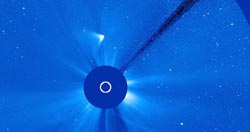ISON stops producing dust

The remains of ISON: On this image taken by satellite Soho, a tail-like structure is moving away from the sun. But now the comet is fading.<br><br>© ESA / NASA / SOHO<br>
On Thursday evening, at the time of its closest approach to the sun, comet ISON still had an active nucleus which was spewing gas and dust. About two hours after the Perihelion passage, however, there were no longer indications for any output.
This is the assessment made by scientists at the Max Planck Institute for Solar System Research in Katlenburg- Lindau on Saturday. They analysed actual pictures of the instrument LASCO which enjoys a unique view of the comet from its vantage point on board of the Solar Observatory SOHO.
On current photographs, the brightness of the apparently inactive comet is gradually decreasing. It is almost certain that there won't be a spectacular comet display after all.
Against 8:30 p.m. yesterday evening, the tail of ISON emerged from behind sun in the field of view of the LASCO instrument. At this point in time, however, it was unclear whether the tip of the tail concealed a nucleus or not. Pictures taken a few hours after Perhelion now allow further conclusions to be drawn.
“The dust tail of the comet is now divided into two parts,” explains Hermann Böhnhardt from the Max Planck Institute for Solar System Research. According to Böhnhardt, the part of the tail that is pointing towards the sun consists of dust particles, which were released significantly before the comet's Perihelion passage – i.e. prior to reaching the closest point to the sun.
The other part, however, appears to contain more recent material: It was released when ISON passed the sun and suggests that at least part of the nucleus still existed and was active at that time.
The Max Planck researchers base their assessment on computer simulations in which they model the shape of the dust tail. “If we assume in our calculations that the comet has emitted dust at Perihelion, we can reproduce the current images quite well,” says Böhnhardt.
The LASCO images from Saturday showed the ISON stopped producing dust two hours after Perhelion. Whether the comet nucleus was still intact at Perihelion or continued its flight as a small fragment or as collection of chunks is not yet clear.
The instrument Sumer on board of the satellite SOHO, which was developed and built under the auspices of the Max Planck Institute in Lindau observed ISON on Thursday night in the hour when it directly approached the sun. The instrument divides the light that is sent into space by the celestial body into its individual components. From this, researchers can draw conclusions about the elements and molecules in the comet's dust cloud.
“Our measurements show a clear signal of the comet during its flight past the sun,” says Max Planck scientist Werner Curdt. Exact results of the measurement, however, are not yet available.
Contact
Dr. Birgit Krummheuer
Press and Public Relations
Max Planck Institute for Solar System Research, Katlenburg-Lindau
Phone: +49 5556 979-462
Fax: +49 5556 979-240
Email:Krummheuer@mps.mpg.de
Dr. Hermann Böhnhardt
Max Planck Institute for Solar System Research, Katlenburg-Lindau
Phone: +49 5556 979-545
Dr. Werner Curdt
Max Planck Institute for Solar System Research, Katlenburg-Lindau
Phone: +49 5556 979-420
Email:Curdt@mps.mpg.de
Media Contact
More Information:
http://www.mpg.de/7621979/winged-cometAll latest news from the category: Physics and Astronomy
This area deals with the fundamental laws and building blocks of nature and how they interact, the properties and the behavior of matter, and research into space and time and their structures.
innovations-report provides in-depth reports and articles on subjects such as astrophysics, laser technologies, nuclear, quantum, particle and solid-state physics, nanotechnologies, planetary research and findings (Mars, Venus) and developments related to the Hubble Telescope.
Newest articles

Silicon Carbide Innovation Alliance to drive industrial-scale semiconductor work
Known for its ability to withstand extreme environments and high voltages, silicon carbide (SiC) is a semiconducting material made up of silicon and carbon atoms arranged into crystals that is…

New SPECT/CT technique shows impressive biomarker identification
…offers increased access for prostate cancer patients. A novel SPECT/CT acquisition method can accurately detect radiopharmaceutical biodistribution in a convenient manner for prostate cancer patients, opening the door for more…

How 3D printers can give robots a soft touch
Soft skin coverings and touch sensors have emerged as a promising feature for robots that are both safer and more intuitive for human interaction, but they are expensive and difficult…





















